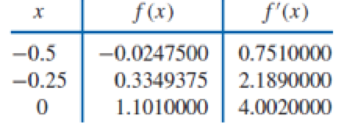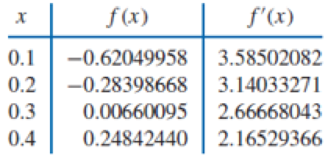
Use Theorem 3.9 or Algorithm 3.3 to construct an approximating polynomial for the following data.




ALGORITHM 3.3
Hermite Interpolation
To obtain the coefficients of the Hermite interpolating polynomial H(x) on the (n + 1) distinct numbers x0, …, xn for the function f:
INPUT numbers x0, x1, …, xn; values f (x0), ... , f (xn) and f′ (x0), ... , f′ (xn).
OUTPUT the numbers Q0, 0, Q1, 1, … , Q2n + 1, 2n + 1 where
Step 1 For i = 0, 1, … , n do Steps 2 and 3.
Step 2
Step 3 If i ≠ 0 then set
Step 4 For i = 2, 3, … , 2n + 1
for j = 2, 3, ... , i set
Step 5 OUTPUT (Q0, 0, Q1, 1, … , Q2n + 1, 2n + 1);
STOP.
Theorem 3.9 If f ∈ C1 [a, b] and x0, …, xn ∈ [a, b] are distinct, the unique polynomial of least degree agreeing with f and f′ at x0, …, xn is the Hermite polynomial of degree at most 2n + 1 given by
where, for Ln, j (x) denoting the jth Lagrange coefficient polynomial of degree n, we have
Moreover, if f ∈ C2n + 2 [a, b], then
for some (generally unknown) ξ(x) in the interval (a, b).
Want to see the full answer?
Check out a sample textbook solution
Chapter 3 Solutions
EBK NUMERICAL ANALYSIS
- Shading a Venn diagram with 3 sets: Unions, intersections, and... The Venn diagram shows sets A, B, C, and the universal set U. Shade (CUA)' n B on the Venn diagram. U Explanation Check A- B Q Search 田arrow_forward3. A different 7-Eleven has a bank of slurpee fountain heads. Their available flavors are as follows: Mountain Dew, Mountain Dew Code Red, Grape, Pepsi and Mountain Dew Livewire. You fill five different cups full with each type of flavor. How many different ways can you arrange the cups in a line if exactly two Mountain Dew flavors are next to each other? 3.2.1arrow_forwardBusinessarrow_forward
- Please explain how come of X2(n).arrow_forwardNo chatgpt pls will upvotearrow_forwardFind all solutions of the polynomial congruence x²+4x+1 = 0 (mod 143). (The solutions of the congruence x² + 4x+1=0 (mod 11) are x = 3,4 (mod 11) and the solutions of the congruence x² +4x+1 = 0 (mod 13) are x = 2,7 (mod 13).)arrow_forward
- https://www.hawkeslearning.com/Statistics/dbs2/datasets.htmlarrow_forwardDetermine whether each function is an injection and determine whether each is a surjection.The notation Z_(n) refers to the set {0,1,2,...,n-1}. For example, Z_(4)={0,1,2,3}. f: Z_(6) -> Z_(6) defined by f(x)=x^(2)+4(mod6). g: Z_(5) -> Z_(5) defined by g(x)=x^(2)-11(mod5). h: Z*Z -> Z defined by h(x,y)=x+2y. j: R-{3} -> R defined by j(x)=(4x)/(x-3).arrow_forwardDetermine whether each function is an injection and determine whether each is a surjection.arrow_forward
- Algebra & Trigonometry with Analytic GeometryAlgebraISBN:9781133382119Author:SwokowskiPublisher:Cengage
 Mathematics For Machine TechnologyAdvanced MathISBN:9781337798310Author:Peterson, John.Publisher:Cengage Learning,
Mathematics For Machine TechnologyAdvanced MathISBN:9781337798310Author:Peterson, John.Publisher:Cengage Learning, Linear Algebra: A Modern IntroductionAlgebraISBN:9781285463247Author:David PoolePublisher:Cengage Learning
Linear Algebra: A Modern IntroductionAlgebraISBN:9781285463247Author:David PoolePublisher:Cengage Learning  Elements Of Modern AlgebraAlgebraISBN:9781285463230Author:Gilbert, Linda, JimmiePublisher:Cengage Learning,
Elements Of Modern AlgebraAlgebraISBN:9781285463230Author:Gilbert, Linda, JimmiePublisher:Cengage Learning,



